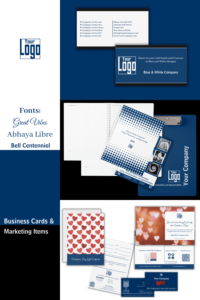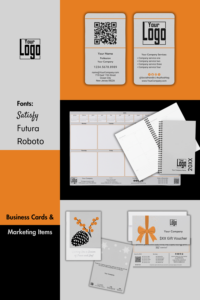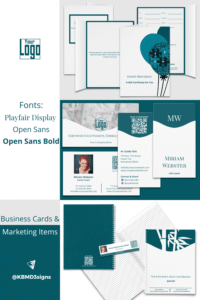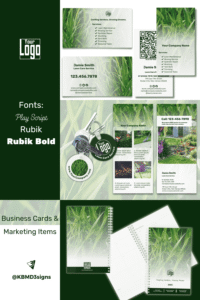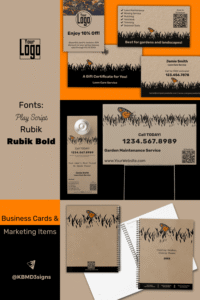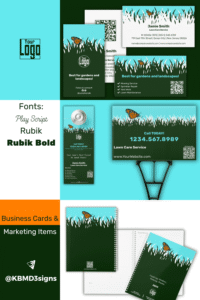A brand style guide and a brand mood board are both tools for communicating and maintaining brand identity, but they serve different purposes. While they contain different levels of detail.

Article Content:
1. The Most Important Criterion Of A Brand Mood Board & A Brand Style Guide
Brand Mood Board:
Visual Snapshot:
A brand mood board is a concise visual snapshot that typically includes the essential visual elements of a brand. It is a one-page or small document that gives a quick overview of the brand’s aesthetic.
Key Visual Elements:
Brand mood boards focus primarily on visual elements such as the logo, color palette, typography, and key imagery. They present these elements in a cohesive layout, allowing for a quick understanding of the brand’s look and feel.
Quick Reference:
Brand mood boards are often used as quick reference tools. They are particularly helpful during the initial stages of brand development, in brainstorming sessions, or when collaborating with design teams.
Less Detailed:
Compared to a brand style guide, brand mood boards are less detailed and may not include extensive guidelines for various applications. They are more about inspiring and conveying the overall visual direction.
Brand Style Guide:
Comprehensive Guidelines:
A brand style guide is a more extensive document that provides comprehensive guidelines for maintaining consistency across all aspects of a brand, including both visual and verbal elements.
Detailed Instructions:
In addition to visual elements, a brand style guide includes detailed instructions on how to use the brand’s visual elements, typography, color palette, voice, and tone in different contexts and applications.
Versatility:
Brand style guides are versatile and serve as a reference for various stakeholders, including designers, writers, marketers, and anyone involved in creating content or materials representing the brand.
Application to Different Mediums:
Unlike brand boards, style guides often include specific instructions for applying the brand across different mediums, such as print, digital, social media, merchandise, and more.
Evolution and Updates:
Brand style guides are dynamic documents that evolve with the brand. They may undergo updates as the brand grows, ensuring that guidelines remain relevant and aligned with the brand’s current strategy.
To summarize, a Brand Board is a quick and visual representation of a brand’s identity, focusing on key visual elements. It is often used for inspiration and to communicate the overall aesthetic. On the other hand, a brand style guide is a more detailed and comprehensive document that provides specific guidelines for maintaining consistency across all aspects of a brand and serves as a reference for a wide range of applications and stakeholders. Both tools play an essential role in building and maintaining a strong brand identity.
2. Who Profits From The Use Of A Brand Board
A brand board is a visual representation of a brand’s identity, bringing together key design elements in a concise and organized manner. It serves as a quick reference tool for internal and external stakeholders to ensure consistent and cohesive brand representation. Here’s how and when a brand board is typically used:
How a Brand Board is Used:
1. Internal Team Reference:
- Designers and Creatives: A brand board is a handy reference for design teams to maintain consistency when creating marketing materials, social media graphics, or any visual content.
- Marketing Teams: Marketers can use the brand board to align their campaigns with the established visual and messaging guidelines, ensuring a unified brand presentation.
2. New Employee Onboarding:
- A brand board is a valuable tool during the onboarding process for new employees. It helps them quickly grasp the visual and verbal aspects of the brand, fostering a consistent understanding across the organization.
3. External Partner Collaboration:
- When working with external agencies, freelancers, or partners, providing a brand board ensures that everyone involved in creating content for the brand is on the same page. This minimizes misunderstandings and streamlines the creative process.
4. Consistency Across Platforms:
- Social media managers, web developers, and content creators can refer to the brand board to ensure that visual elements are consistent across various digital platforms, maintaining a cohesive online presence.
5. Pitching and Presentations:
- Sales teams and executives can use the brand board when creating presentations, pitches, or proposals. It ensures that external stakeholders get a clear and unified impression of the brand.
6. Merchandising and Product Development:
- For companies that produce physical products, a brand board guides product designers, packaging teams, and merchandisers in maintaining a consistent brand appearance across product lines.
When a Brand Board is Used:
1. Brand Development Stage:
- During the initial stages of brand development, seasonal and holiday brand developments, or rebranding, a brand board is created to establish and communicate the brand’s visual identity, including the logo, color palette, typography, and other key design elements.
2. Design Projects:
- Whenever a new design project is initiated, a brand board can be referenced to ensure that the design aligns with the established brand guidelines. This is especially important for maintaining visual consistency across different materials.
3. Campaign Planning:
- Before launching marketing campaigns, a brand board is consulted to ensure that campaign visuals and messaging are in line with the overall brand identity.
4. Periodic Reviews and Updates:
- As brands evolve, it’s essential to review and, if necessary, update the brand board. This ensures that it remains reflective of the brand’s current positioning and visual preferences.
5. Collaborative Projects:
- Whenever collaboration is required with external partners or agencies, sharing the brand board at the project outset ensures a shared understanding of the brand’s visual and messaging guidelines.
A brand board, with its visual simplicity and comprehensive information, is an invaluable tool for maintaining brand consistency across diverse applications and scenarios. By using it strategically, organizations can safeguard their brand identity and reinforce a strong, recognizable presence in the market.
⇒ Explore our Cocoon It store on Zazzle for marketing materials as templates, in defined brand colors or modifiable colors. These are holiday specific or with seasonal adjustments.
3. Crafting a Cohesive Identity: The Importance of a Brand Style Guide
In today’s highly competitive business landscape, establishing a strong and memorable brand identity is crucial for success. A brand style guide serves as the blueprint for maintaining consistency and cohesion across all brand communications. Whether you’re a startup or an established enterprise, having a well-defined brand style guide can be a game-changer in building a recognizable and trustworthy brand. In this article, we’ll explore the significance of a brand style guide and how it contributes to a brand’s overall success.
Defining a Brand Style Guide
A brand style guide, also known as a brand book or brand manual, is a comprehensive document that outlines the elements, guidelines, and rules that dictate how a brand presents itself to the world. It serves as a reference for anyone involved in creating content for the brand, ensuring that every piece of communication aligns with the brand’s values, personality, and visual identity.
Elements of a Brand Style Guide
1. Brand Vision and Values:
- Clearly articulate the mission, vision, and values that drive the brand. This section provides a foundation for understanding the brand’s purpose and ethos.
2. Logo Usage:
- Specify guidelines for the logo’s size, placement, color variations, and clear space. This ensures that the logo maintains its integrity across various mediums and platforms.
3. Color Palette:
- Define the primary and secondary color schemes, specifying color codes for both print and digital media. Consistent use of colors contributes to brand recognition.
4. Typography:
- Outline the fonts and typography styles that should be used in different contexts. This includes guidelines for headings, subheadings, body text, and any other textual elements.
5. Imagery and Photography:
- Provide guidelines on the types of images and photography styles that align with the brand. This could include preferred image treatments, filters, and composition guidelines.
6. Voice and Tone:
- Establish the brand’s voice and tone in written communication. Whether the brand is friendly, formal, or playful, maintaining a consistent tone helps build a strong brand personality.
7. Design Elements:
- Detail any specific design elements, patterns, or icons that are integral to the brand’s visual identity. This ensures a cohesive look and feel across all brand materials.
Benefits of a Brand Style Guide
1. Consistency:
- A brand style guide ensures that all brand communications, regardless of the medium or creator, adhere to a unified and consistent look. This consistency builds trust and recognition among the audience.
2. Efficiency:
- With clear guidelines in place, content creators can work more efficiently, knowing the dos and don’t s of brand representation. This leads to faster decision-making and a streamlined creative process.
3. Brand Recognition:
- A well-executed brand style guide helps in creating a distinctive brand identity that stands out in the market. Consistent visuals and messaging contribute to improved brand recall among consumers.
4. Adaptability:
- As brands expand and diversify their content across various channels, having a brand style guide allows for easy adaptation while maintaining a cohesive identity.
To conclude, in an era where brand perception is paramount, a Brand Style Guide is a valuable tool to help shape and protect a brand’s identity. It goes beyond visual elements to encompass the entire spectrum of how a brand communicates with its audience. By investing time and resources in creating and maintaining a comprehensive brand style guide, companies can establish a strong and lasting connection with their target audience. Ultimately, this guide contributes to long-term success and brand loyalty.
4. What is the format of a brand style guide?
A brand style guide typically follows a structured format to provide clear and comprehensive guidance for maintaining consistency in a brand’s visual and messaging elements. While the specific format may vary depending on the organization’s needs, the following elements are commonly included in a brand style guide:
4-1. Introduction:
- Provide a brief overview of the brand, its history, mission, and values. This section sets the tone for the rest of the guide and helps readers understand the context in which the brand operates.
4-2. Brand Overview:
- Summarize the key attributes of the brand, including its personality, positioning, and target audience. This section serves as a quick reference for anyone engaging with the brand.
4-3. Logo Usage:
- Detail guidelines for the logo, including variations, minimum size, placement on different backgrounds, and rules for clear space around the logo.
4-4. Color Palette:
- Present the primary and secondary color schemes with corresponding color codes for both print and digital media. Include information on when to use each color and any restrictions on color combinations.
4-5. Typography:
- Specify the fonts and typography styles to be used in various contexts, such as headings, subheadings, body text, and other textual elements. Include guidelines on font sizes, spacing, and formatting.
4-6. Imagery and Photography:
- Define the preferred style of images and photography, including any specific treatments, filters, or editing guidelines. Provide examples to illustrate the desired visual aesthetic.
4-7. Voice and Tone:
- Articulate the brand’s voice and tone in written communication. Include examples of messaging that align with the brand personality, and provide guidance on adapting the tone for different contexts.
4-8. Design Elements:
- Outline any additional design elements, patterns, icons, or graphics that contribute to the brand’s visual identity. Include specifications on their usage and placement.
4-9. Usage Guidelines:
- Provide practical guidance on applying the brand elements across various mediums, such as print materials, digital platforms, social media, and merchandise. Address any specific considerations for different channels.
4-10. Examples and Non-Examples:
- Include visual examples that showcase correct and incorrect applications of the brand guidelines. This helps reinforce understanding and provides a visual reference for users.
4-11. Application to Marketing Collateral:
- Extend the guidelines to specific marketing collateral, such as business cards, brochures, advertisements, and digital assets. Include templates or examples to guide content creators.
4-12. Contact Information:
- Provide contact details for individuals or teams responsible for overseeing and enforcing the brand guidelines. This ensures that stakeholders can seek clarification or approval when needed.
4-13. Revision History:
- Document any updates or revisions made to the brand style guide. This section helps users stay informed about the most recent version and any changes that may impact their work.
By organizing a brand style guide in a clear and accessible format, organizations can empower their teams and partners. It enables them to present the brand consistently across multiple channels. This strengthens brand identity and recognition.
5. Time to Use a Brand Style Guide
A brand style guide is a comprehensive document that provides guidelines and standards for consistently representing a brand across various channels. It serves as a reference tool to ensure that all brand elements, from visual to messaging, align with the established identity. Here’s how and when to use a brand style guide:
How a Brand Style Guide is Used:
1. Design Consistency:
- Visual Elements: Designers refer to the style guide to maintain consistency in the use of logos, color palettes, typography, imagery, and other visual elements. This ensures a cohesive and recognizable brand identity across different materials.
2. Content Creation:
- Messaging and Voice: Writers and content creators consult the brand style guide to understand the brand’s voice, tone, and messaging guidelines. This helps maintain a consistent communication style that resonates with the brand’s personality.
3. Marketing Materials:
- Advertising and Promotions: Marketing teams use the style guide when creating promotional materials, advertisements, and marketing campaigns. It ensures that all collateral aligns with the brand’s visual and messaging standards.
4. Digital Presence:
- Website and Social Media: Web developers, social media managers, and content creators refer to the style guide when updating or creating digital content. This includes maintaining a consistent look on the website and across various social media platforms.
5. Printed Materials:
- Brochures, Business Cards, and Merchandise: Print designers use the style guide to create materials such as brochures, business cards, and merchandise, ensuring a unified brand appearance across all printed materials.
6. Email Communication:
- Email Campaigns: Those responsible for email marketing utilize the style guide to maintain a consistent look and feel in email campaigns, aligning with the brand’s visual and messaging guidelines.
7. Collaboration with Partners:
- External Agencies and Partners: When collaborating with external agencies, vendors, or partners, sharing the brand style guide ensures that all parties involved understand and adhere to the brand’s identity standards.
When a Brand Style Guide is Used:
1. Brand Launch or Rebranding:
- When a brand is initially launched or undergoes a rebranding effort, the style guide is created as a foundational document to communicate the new visual and messaging identity.
2. Employee Onboarding:
- As part of the onboarding process, new employees are introduced to the brand style guide to familiarize them with the brand’s identity, ensuring a consistent understanding across the organization.
3. Design Projects:
- Whenever a new design project is initiated, whether it’s for marketing materials, product packaging, or digital content, the brand style guide is referenced to maintain consistency.
4. Content Creation:
- Before creating any content, whether it’s a blog post, social media update, or marketing campaign, content creators consult the style guide to align their work with the brand’s voice and visual identity.
5. Periodic Review and Updates:
- The brand style guide should be periodically reviewed and updated to accommodate changes in the brand’s strategy, visual trends, or market positioning. This ensures that the guide remains relevant and effective.
6. Quality Assurance:
- The style guide serves as a tool for quality assurance, allowing teams to check that all brand elements in any communication meet the established standards.
7. International Expansion:
- When a brand expands internationally, the style guide may be adapted to suit cultural nuances and preferences while maintaining core brand elements. This ensures a consistent global brand presence.
A well-maintained brand style guide is a dynamic document that evolves with the brand. By using it consistently across touch-points and scenarios, organizations can protect their brand identity, reinforce a strong market presence, and build trust with their audiences.
-

6 Winter Marketing Ideas for Small Businesses
Read the post …: 6 Winter Marketing Ideas for Small Businesses -

6 Offline Summer Marketing Ideas for Small Businesses
Read the post …: 6 Offline Summer Marketing Ideas for Small Businesses -

What is Seasonal Marketing? A Guide for Small Business Offline Success
Read the post …: What is Seasonal Marketing? A Guide for Small Business Offline Success
6. FAQs about Brand Boards and Style Guides:
A brand board is a visual representation that includes key design elements of a brand, such as the logo, color palette, typography, and imagery. It provides a quick snapshot of the brand’s visual identity.
A brand board is a concise visual overview, while a brand style guide is a comprehensive document with detailed guidelines for maintaining consistency in a brand’s visual and messaging elements.
Brand boards are often created during the initial stages of brand development, rebranding efforts, or for quick reference in design brainstorming sessions.
A brand board typically includes the logo, color palette, typography, and key imagery. It focuses on the essential visual elements that define the brand’s aesthetic.
Designers and creatives use brand boards as a quick reference and source of inspiration during the creative process. It helps ensure that visual elements align with the brand’s overall identity.
A brand style guide is a comprehensive document that provides detailed guidelines and standards for maintaining consistency across a brand’s visual and messaging elements. It covers a broader range of applications.
A brand style guide is essential for ensuring consistent brand representation. It helps maintain a unified identity across different channels, builds brand recognition, and fosters trust with the audience.
A brand style guide typically includes guidelines for the logo, color palette, typography, imagery, voice and tone, design elements, and usage instructions for various mediums.
A brand style guide should be periodically reviewed and updated to reflect any changes in the brand’s strategy, visual trends, or market positioning. It ensures that the guide remains relevant and effective.
A brand style guide is used by various stakeholders, including designers, writers, marketers, and anyone involved in creating content or materials representing the brand. It serves as a reference for maintaining consistency.
Yes, a brand board can be included as a visual component within a brand style guide. It can serve as a quick reference within the larger document, offering a visual snapshot of the brand’s identity.
External partners, such as agencies or vendors, benefit from a brand style guide by ensuring that their work aligns with the brand’s identity standards, fostering consistency in collaborative projects.
No, brand style guides are valuable for businesses of all sizes. They provide a framework for maintaining consistency and building a strong brand identity, which is crucial for brand recognition and trust, regardless of size.
Yes, a brand style guide can be adapted to suit international markets. It may include considerations for cultural nuances and preferences while maintaining core brand elements for a consistent global presence.
-

What Is A Brand Partnership? – A Small Business Perspective
Read the post …: What Is A Brand Partnership? – A Small Business Perspective -
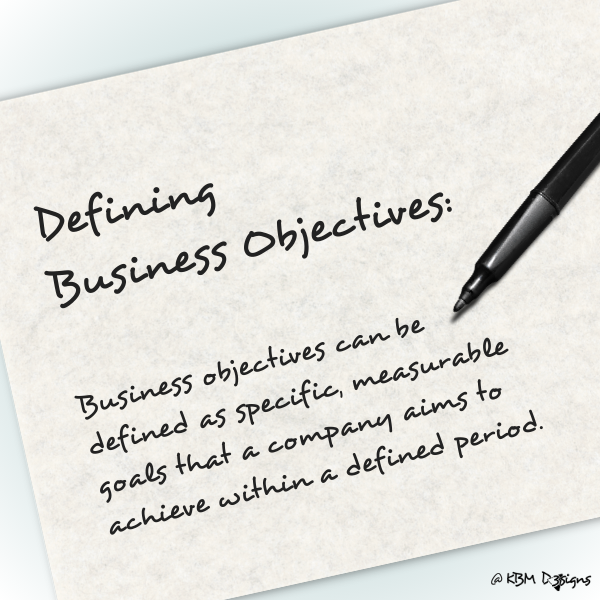
What Are Business Objectives?” Perspective Of A Small Business
Read the post …: What Are Business Objectives?” Perspective Of A Small Business -

What Is A Focus Group Market Research? – SMB Perspective
Read the post …: What Is A Focus Group Market Research? – SMB Perspective



